Why should I visit Zimbabwe?
Here are the top five reasons why you should visit Zimbabwe:
- Victoria Falls – largest falls in the world
- Hwange National Park – safari on the doorstep of the Victoria Falls
- Mana Pools – remote, beautiful and wild
- Matusodona – safari on Lake Kariba
- Lake Kariba – explore the largest reservoir in the world on a houseboat
While Zimbabwe has had decades of political mismanagement, its wildlife and the magnificent Victoria Falls have, for the most part, continue to thrive. The great Zambezi River, offers an added dimension to your safaris in Mana Pools, Matusodona and cruises on Lake Kariba.
With Hwange being only a 2 hour drive or a short flight from Victoria Falls, combining the 7th natural wonder of the world with a safari is almost seamless. The Victoria Falls can also be easily combined with the Chobe in Botswana.
What is the best time to visit Zimbabwe?
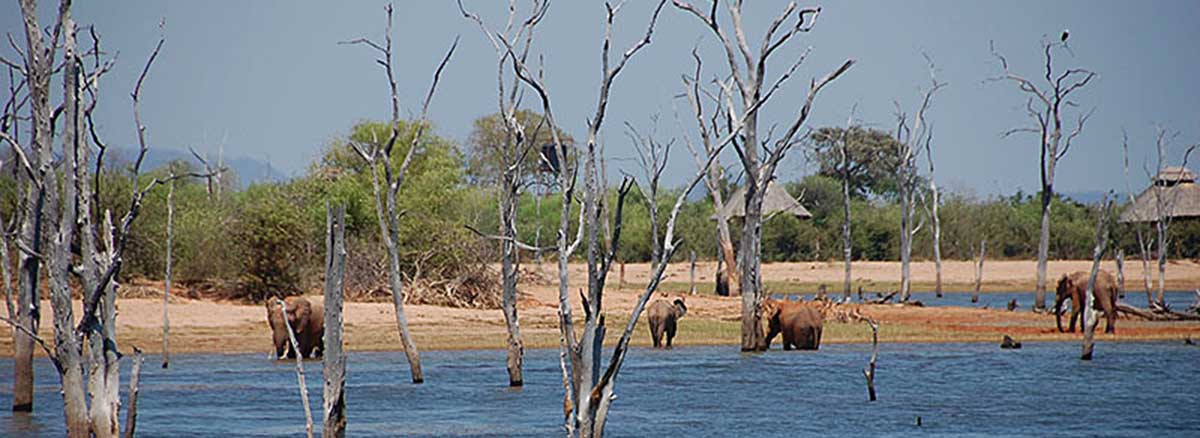
Dead trees and elephants – Matusodona
The best time to travel to Zimbabwe depends on what you are wanting to experience.
For safari, the best time is the dry season which is June to November.
For birding, the best time is the wet season from December to April
If you want to see the Victoria Falls when it is full of water, March to May is the best time
The general rule of thumb is that the areas in the Zambezi Valley are hot and humid while the highlands are milder, but still mostly warm at night.
For birders, the best time to visit is between November and April when the resident species are joined by the migrant species.
Which places should I include in my visit?
Zimbabwe with its political turmoil, fuel shortages and general unrest has in effect restricted your experience in Zimbabwe to Victoria Falls, Lake Kariba and a variety of safari destinations. These areas are safe to travel to, but Zimbabwe has so much more to offer, but as these are most easily accessible by self-driving, visits to these areas are not recommended at this time.
If you are comfortable and are experienced in self-drive trips in Africa, places that would be of interest are the Great Zimbabwe Ruins, Matobo Hills and the eastern highlands.
For those not quite as adventurous, no trip to Zimbabwe is complete without including Victoria Falls in your itinerary. If you have some time to spend, in addition to Victoria Falls add on Hwange, Matusodona or Mana Pools (one or all as they are very different) and perhaps a few days cruising Lake Kariba.
How long should I visit Zimbabwe for?
For a short stay, you can fly into Victoria Falls for a 2 or 3-night stay. I personally could stay longer as there are so many activities to fill my time. If you just want to experience a cruise on Lake Kariba, a 3 or 4-night stay would be sufficient.
If you have 5 nights or more, I suggest that you combine Victoria Falls with Hwange, Matusodona or Mana Pools.
For a combination of Victoria Falls, Hwange, Matusodona and Mana Pools and 11 or 12-night stay would be in order.
What is the weather like in Zimbabwe?

Thunderstorm over Zimbabwe
Zimbabwe, which lies north of the Tropic of Capricorn, is in the tropical zone, but because most of the country is on a high-lying plateau it experiences a variety of climates. The southern and western areas are warm and dry, the far southeast is very dry, the eastern highlands and central areas, temperate to subtropical and the northern areas, tropical.
Zimbabwe, except for the central and north regions, experiences the traditional 4 seasons, namely summer, autumn, winter and spring. October to March is considered summer, April & May, autumn, June to August, winter and September spring. Days are usually hot and during the winter, nights can get cold. In the north, it is hot and humid for most of the year. The year in the central and northern regions is rather defined as the rainy or dry season.
Zimbabwe’s rainy season is from November to March and dry season from May to October. The eastern parts of Zimbabwe receive more rain than the western areas and the rainy season also starts earlier and ends later.

Harare and Central Plateau Climate Chart
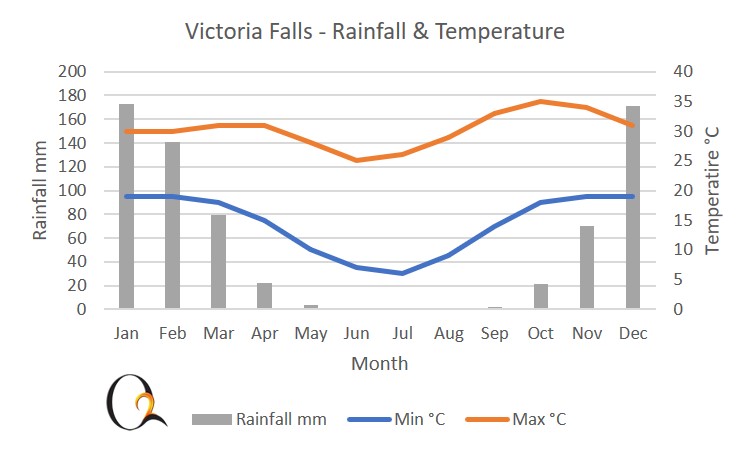
Victoria Falls and Zambezi Valley Climate Chart
Do I need a visa to travel to Zimbabwe?
Visa requirements fall into 3 categories; Those that do not require a visa to visit Zimbabwe, those that do need a visa but can also get their visa on arrival and those that must have a visa prior to travel.
Visa can be obtained in one of 3 ways: Online, at a Zimbabwean High Commission/Embassy or on arrival. Please check before you travel what the requirements are for your country.
A KAZA Uni visa is available at port of entry. It allows access to Zimbabwe, Zambia and Botswana on the one visa. Again, the above methods of obtaining the visa must be checked before travel.
What are the health requirements for Zimbabwe?
Zimbabwe is a malaria risk area. Anti-malaria medication is recommended, and you should consult your doctor in this regard. To minimise the risk of contracting malaria, wear long trousers and cover your arms in the evening, and apply mosquito repellent.
Zimbabwe is a malaria risk area. Anti-malaria medication is recommended, and you should consult your doctor in this regard. To minimise the risk of contracting malaria, wear long trousers and cover your arms in the evening, and apply mosquito repellent.
Yellow fever vaccination is required if you are coming from an endemic country. The following vaccinations are recommended, but not compulsory:
- Hepatitis A & B
- Typhoid
- Tetanus, Diphtheria & Pertussis (TDAP)
- Mumps, Measles and Rubella (MMR)
- Chickenpox
- Shingles
- Pneumonia
- Influenza
- Rabies
- Meningococcal meningitis
How can I travel around in Zimbabwe
Only the main tar roads in Zimbabwe are in reasonable condition and this could quite quickly change during the rainy season. As Zimbabwe is in a financial crunch (2019), there may or may not be funds to provide the necessary upkeep on the roads. Car rental for self-driving is an option in Zimbabwe, but we suggest that you inquire just before travelling due to the changing political, safety and economic conditions.
Most tourists fly into Zimbabwe. Light aircraft transfers are available between Harare/Victoria Falls and the main tourist attractions. Air-conditioned vehicles, most in good repair, are available in all the major centres, for transfer or to hire together with a driver and /or guide.
Long distance luxury busses connect Harare with South Africa and local busses and taxis are available almost everywhere, but this is not recommended.
Train travel is possible in Zimbabwe, but not recommended.
TOP TOURIST ATTRACTIONS
Victoria Falls & Town
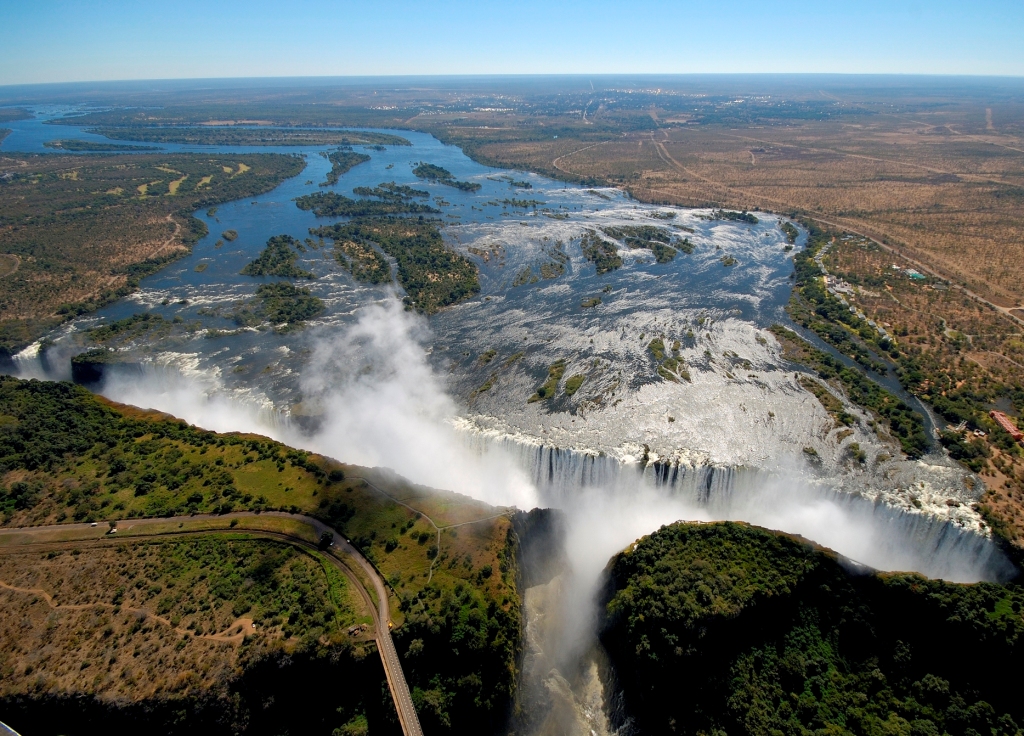
7th natural wonder of the world – Victoria Falls
The Victoria Falls is one of the seven natural wonders of the world and quite rightly so. It is the largest sheet of falling water in the world, in this respect the world’s largest waterfall. The Falls are just over 1.7km long and 108 m deep.
The Victoria Falls is the boundary between Zimbabwe and Zambia with approximately two thirds of the length of the falls being in Zimbabwe. When the river is full or in flood, water falls from the entire length of the Falls, but during the dry season, the majority of the water goes through the Devil’s Cataract, which is on the Zimbabwean side.
The falls can only be viewed from the Victoria Falls National Park, which extends from 6km above the Falls to 12 km downstream.
Victoria Falls town owes its existence to the falls. Mainly a tourist town, it has many hotels, a number of restaurants and a train station. The airport is about a 20 min drive form the town itself.
Victoria Falls one of the best places in the world to enjoy adventure activities. Activities like, white water rafting, flying fox, bunjee jumping, gorge swing and abseiling are not for the faint-hearted. There are however activities that can be done by the whole family. These include: helicopter flips (one of my favourites), canoeing on the Upper Zambezi, fixed wing flights, microlight flights, jet boating, cultural visits, game drives, shopping as well as dinner or sunset cruises on the Zambezi. Swimming in the Devil’s Pool on Livingstone island has to rate as one of the craziest things you can do, as from the pool, you can lean out over the drop the Victoria Falls plunges over.
The list of activities above is by no means exhaustive, but gives you an idea of the range of activities available. We recommend a minimum 3-night stay at Victoria Falls to enjoy at least some of the activities.
Hwange National Park

Elephants around a waterhole – photo by Christine Donaldson
Hwange lies about 2 hours drive from Victoria Falls. It is largest national park in Zimbabwe, at 14 650 km², and is made up of the National Park and several private concessions, both in and just outside the National Park (much the same as the greater Kruger National Park).
Hwange has savannah, rivers, dams, pans and forests. Habitats range from semi-desert in the west to teak forests in the east which is the reason that you will find over 400 bird species.
Known to have some of the largest elephant herds in the world, Hwange is also a great place to spot wild dogs. Hwange is home to the Big 5, including black and white rhino, cheetah and wild dog. Clients can self-drive in the National Park but can only leave camp after sun-up and must be back in camp by sundown. This rule does not apply to the private concessions (self-drivers not allowed in these areas) where night game drives and walking is possible.
Hwange is much wilder and gives more of a feeling of remoteness than the northern part of the Chobe National Park (often referred to as Chobe) which can be very busy and congested. Hwange and Chobe are approximately the same travelling time from Victoria Falls, but the experience is much more authentic in Hwange.
Hwange has several airstrips that clients can fly into if they prefer not to arrive by road.
Zambezi National Park

Zambezi National Park
The Zambezi National Park is adjacent to the Victoria Falls National Park in the east and extends about 50km along the Upper Zambezi in the northwest. The main road between Victoria Falls and Kasane bisects the park, with the northern section referred to as the riverine section and the southern section the Chamabonda Vlei section.
Home to all the Big 5, (excluding the rhino) and with the Zambezi River as its northern boundary, Zambezi National Park offers a great safari and river experience, right on the doorstep of the Victoria Falls. This fact is attested to but quite a few safari lodges opening up on the Zambezi River in this park. The traditional game drives while on safari are supplement by game boat and sunset cruises adding an extra dimension to your stay here.
Lake Kariba
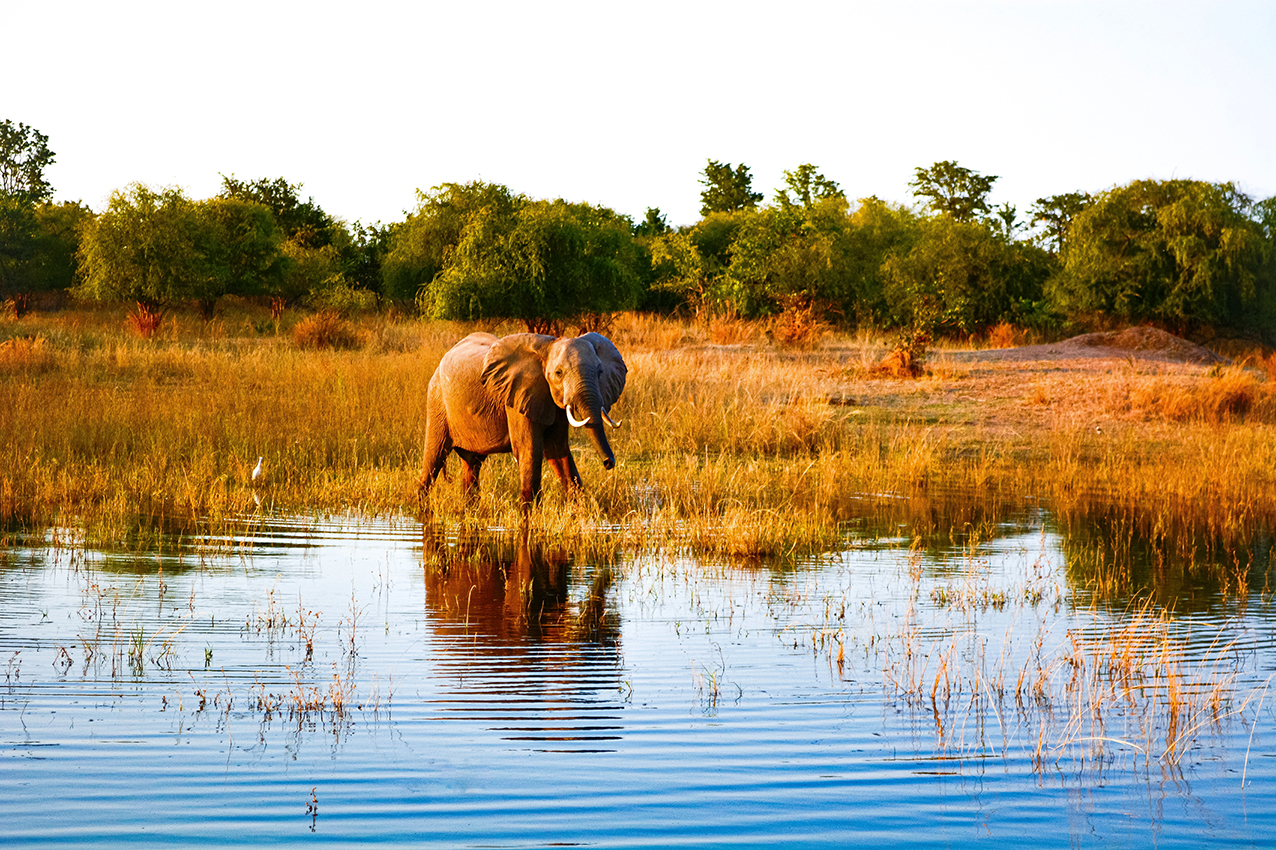
Lake Kariba – photo by Arpit Rastogi
Lake Kariba is the world’s largest man-made reservoir by volume. With the damming of the Zambezi River, the valley flooded 226 km upstream from the Kariba Dam wall and in places gets up to 40km wide. Over 57000 people and 6000 animals that lived in the areas now flooded under the waters of Kariba Dam, were translocated during Operation Noah.
Built to supply both Zimbabwe and Zambia with hydroelectric power to fuel their economies, Lake Kariba also offers the tourist beautiful sunsets, game viewing, tender boating along its shores and excellent fishing (including tiger fish in season). There are few things as special as relaxing on your houseboat enjoying a good meal or sipping sundowners while watching the calm waters (most of the time) of Lake Kariba float by.
While most of the house boats are moored at Kariba Harbour, there are a few companies that offer boats at Binga. There is one company (2019) that offers multiday cruises for individuals or groups that start either from Binga or Kariba Town.
Kariba has several islands, some of which house luxury lodges. Fothergill Island is the most well-known of these.
Matusodona National Park
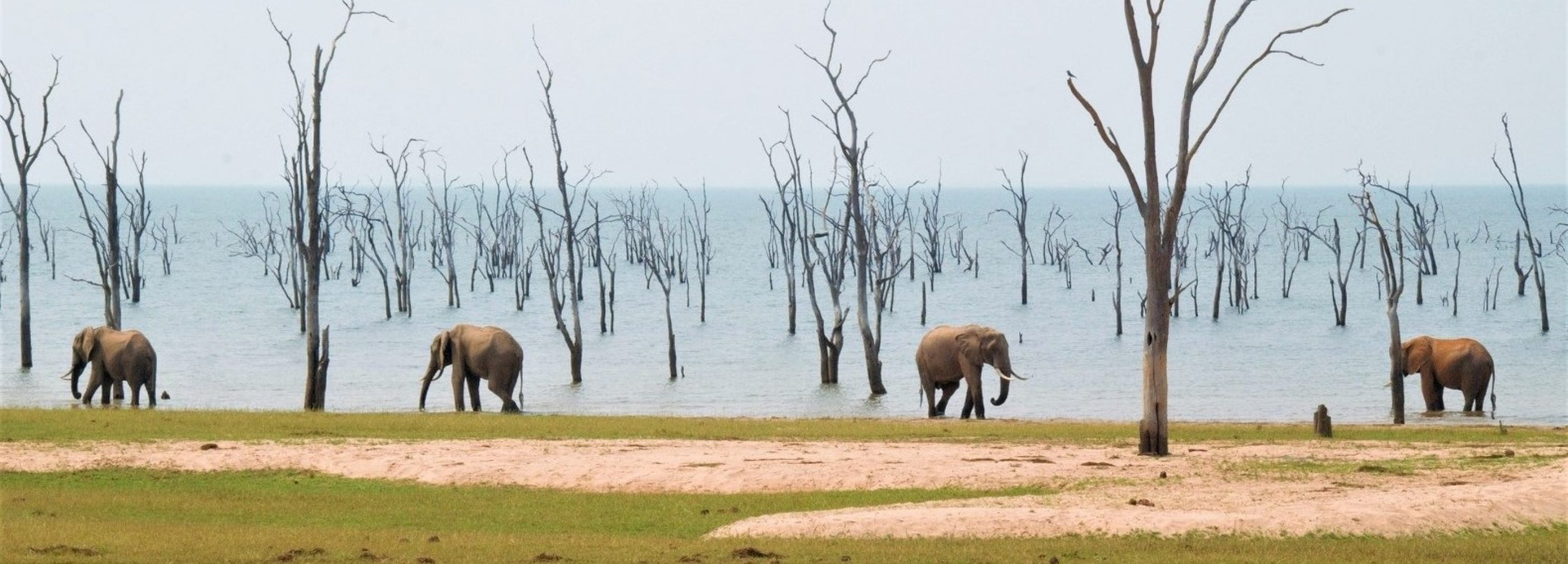
Matusadona
During Operation Noah, much of the game that was relocated found its way to the Matusodona and Chete Safari Area. It was declared a National Park in 1963. Home to the Big 5 (black and white rhino have been reintroduced) and cheetah, with the backdrop of Lake Kariba is a truly special experience.
The central plateau, with its rolling savannah plains and bush, extends towards the Zambezi River. It is cut by river courses and the Matusodona mountain range that drops to the shores of Lake Kariba. All this is part of the Matusodona National Park that extends from Sanyati Gorge in the east to the Ume river in the west. The Sanyati gorge is well known as being spectacular, wild and rugged. A series and bays, coves and islands just off the mainland, makes for a varied and scenically beautiful experience.
This is a great place for walking safaris (including rhino tracking), game drives, canoeing and boat trips. Fishing, particularly tiger fishing in season, is excellent as is birding.
Matusodona is accessible by light aircraft, 4×4 vehicles and boats only. It is not a self-drive destination as it is best explored while staying at a lodge on the shores of the Zambezi River.
Mana Pools

Mana Pools – views towards the Zambia escarpment
Mana Pools is situated downstream of the Kariba Dam and opposite the Lower Zambezi National Park. To understand its uniqueness, you have to understand its annual cycle. The Zambezi River floods during the summer and the flood plains of Mana Pools fill with water resulting in lakes and pools. The wildlife moves to the higher ground of the escarpment only to return to the flood plains and the Zambezi River itself when the ground starts drying out in about April.
With most lodges and camping sites closed during the wet season, Mana Pools is open for business during the dry season. Mana Pools offers a true wilderness experience and you will often find yourself alone on a game drive. Known as Zimbabwe’s best National Park, Mana Pools is one of the best places to see wild dog and to experience walking safaris. It is the only national park in Zimbabwe where you can walk unguided. Other activities include game drives, boat trips and canoeing.
Home to the Big 5 (excluding rhino), cheetah and wild dog, large herds of buffalo, elephant and plains game, Mana Pools offers a superior safari experience in a variety of habitats ranging from flood plains and savannah to forests and hills. The one notable species that is absent is the giraffe which never occurred here naturally.
Part of the beauty of this park, are the floodplains of green, the blue Zambezi River with the Zambian escarpment in the background.
Access is by 4×4 vehicle or by light aircraft.
Gonarezhou National Park

The red cliffs of Gonarezhou
Situated in the semi-arid region in the southwest of Zimbabwe, Gonarezhou National Park is the second largest national park in Zimbabwe. Eons ago, water eroded the sandstone leaving behind the characteristic sandstone cliffs, the most well-known are the red Chilojo Cliffs, that overlook the Runde River. The Save, Runde and Mwenezi Rivers have carved out steep gorges with waterfalls and rapids making the area spectacularly beautiful. Adjacent to Gonarezhou is the Malilangwe Wildlife Reserve. The perennial Chiredzi River runs north to south along the western border of the reserve and sandstone hills and the Runde runs east to west, bisecting the property. These features make for a varied landscape, range of habitats which in turn support a wide variety of wildlife. In addition there are over 80 bushmen painting sites to add a little ancient flavour to your safari.
Gonarezhou is part of the Greater Limpopo Transfontier Park together with the Kruger National Park in South Africa and Gaza in Mozambique. These parks, together with private and communal land, form a conservation area of 100 000 km².
Home to over 11 000 elephants, black and white rhino and the rest of the Big 5, Gonarezhou also has a healthy population of wild dogs. The rivers have over 50 species of fish, including Tiger Fish and over 400 species of bird. 6% of the endemics of Southern Africa are found here.
Gonarezhou is accessed by 4×4 vehicle or by light aircraft.
Matobo National Park
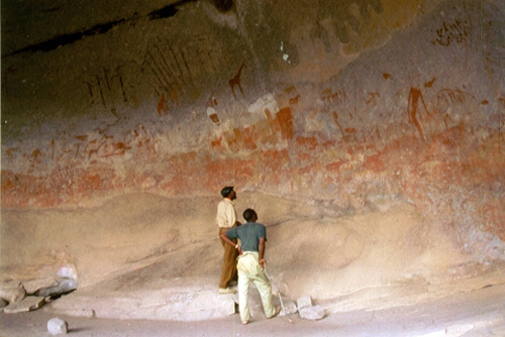
Bushmen paintings in the Matobo Hills
This is a world of massive granite hills, steep valleys and small swamps (vlei areas). The granite hills are home to many large caves and ancient Khoikhoi paintings. The park is just south of Bulawayo and has the world’s densest population of leopards. Black and white rhino have recently been reintroduced.
The park is accessible by motor vehicles.
With so much to offer, Zimbabwe should be your next trip. Contact Q2 Travel to help you with your arrangements.
GENERAL INFO & HISTORY

Zimbabwe Flag
The Republic of Zimbabwe is a land-locked country in southern Africa and is surrounded by South Africa, Botswana, Zambia, Namibia and Mozambique. The country is 390 000 km² and has 16 official languages. The population is about 17 million people (2019).
Brief History
The Khoisan were the earliest modern inhabitants of Zimbabwe. Essentially hunter-gatherers, they lived off the land and did not pursue any form of agriculture. The Bantu people from west of the Great Lakes moved down into the area around the 4th century AD. By the 9th century, the Kalanga speaking peoples had established a reasonably sophisticated trading centre in the Mapungubwe region (near the area where the Limpopo and Shashe Rivers meet). The first European traders in this area were the Portuguese who traded cloth and glass for ivory and copper. The Kalanga then moved to the Zimbabwean highlands during the period 1250 to 1450 AD and formed the Kingdom of Zimbabwe that eclipsed the Kingdom of Mapungubwe but used the same basic architectural style. The power of this kingdom came from controlling the gold trading route. The ruins of the Great Zimbabwe are remnants of this kingdom. In the next 310 years until 1760, the Kingdom of Zimbabwe was replaced by the Kingdom of Mutapa. The extent of this kingdom included what is Zimbabwe today and some parts of Mozambique. The Mutapa Empire established trade routes for gold with the Arabs and Portuguese.
As the Portuguese presence in Africa grew, they aimed to connect the coastal areas of Mozambique with Angola, a Portuguese colony on the west coast of Africa. This meant trade would pass through Zimbabwe. The Portuguese, to secure this trade route, warred with the Mutapa Empire bringing it to its knees. A new Kalanga kingdom, the Rozwi Empire rose up and in turn defeated the Portuguese and pushed them from the Zimbabwean plateau.
In 1821, Mzilikazi, a Zulu general rebelled against the Zulu king Shaka, and formed his own tribe, the Ndebele. The Ndebele moved into the Transvaal. To consolidate their power, they killed and subjugated all opposition between 1826 and 1836 in what became known as the Mfecane Wars. This led them to controlling almost all of the Transvaal.
In 1836, the Boers moved into the Transvaal and the Ndebele moved further north into Zimbabwe settling near Bulawayo in what became known as Matabeleland. Mzilikazi conquered the Rozwi Empire and the Shona people of Mashonaland. The Shona speakers were required to pay tribute to the Ndebele. Mzilikazi’s son, Lobengula signed a concession agreement with Cecil John Rhodes (British) for the mining rights in Matabeleland and Mashonaland. Using this concession, through the vehicle of his company the British South Africa Company (BSAC), he arranged with the British government to negotiate similar concessions for the territory between the Limpopo and Lake Tanganyika, in exchange for promoting the colonization of this area by the British and its control over labour and mining rights. In 1898, the area between the Limpopo and Zambezi Rivers became known as Southern Rhodesia. These agreements with the Ndebele and Shona, resulted in mass colonization which ended up displacing the indigenous peoples of the area with most land becoming the possession of the British colonials.
In 1923, Southern Rhodesia became a self-governing colony. After World War II, in 1953, the British merged Southern and Northern Rhodesia and Malawi into the Central African Federation. This federation was dissolved ten years later due to strong internal opposition and Southern Rhodesia became an independent colony again. During this period, due to pressure from the African people, a new constitution is drawn up allowing for African representation in government. This prompted the formation of African political parties. The most notable of these parties are the Zimbabwe African People’s Union (ZAPU), formed in 1961 under Joshua Nkomo and the Zimbabwe African National Union (ZANU), which splinters off from ZAPU in 1963, headed by Robert Mugabe.
As a backlash to the change in constitution, Ian Smith formed a new party, the Rhodesian Front, which surprisingly won the elections in 1962. After the dissolution of the Central African Federation in 1964, Ian Smith had Joshua Nkomo and Robert Mugabe arrested and banned their parties. They remained incarcerated until 1974. Ian Smith then tried to secure independence from Britain where white minority rule was guaranteed. The British refused.
In 1965, the Rhodesian government under Ian Smith, declared independence from Britain via the Unilateral Declaration of Independence (UDI). The British started negotiations with the Smith government which proved fruitless and Rhodesia became an independent republic in 1970. Rhodesia was not recognised by any other nation and the United Nations instituted sanctions on Rhodesia in 1968.
During the ensuing years, ZANU and ZAPU waged a guerrilla war against the Smith government. Conflict between the two leaders, Mugabe and Nkomo, resulted in Joshua Nkomo fleeing the country. Ideological differences plagued their relationship as well as the age-old rivalry between the Shona (Mugabe) and Ndebele (Nkomo). In 1976, they buried the hatchet and formed one party the Patriotic Front.
In 1978, recognising the need for concessions, Smith came to an agreement with bishop Abel Muzorewa of the United African National Council (UANC). The agreement secured white economic and political rights in exchange for multi-racial elections. Elections were held in 1979, where the banned Patriotic Front was not able to take part. Abel Muzorewa became prime minister of the transitional government with ZANU and ZAPU continuing the guerrilla war.
In 1979, resulting from talks in London involving all three African leaders, the UDI was repealed and Britain made funds available to buy the land from the British farmers wanting to sell. The land was to be redistributed. Elections were held in 1980 which were convincingly won by Robert Mugabe’s ZANU party and Rhodesia became known as Zimbabwe. Initially Mugabe retained Ian Smith in the government, gave Nkomo a cabinet position and respected the political rights of the white minority.
Once again the historical enmity between the majority Shona and the minority Ndebele surfaced and Nkomo was booted from cabinet in 1982. In 1987, Nkomo and Mugabe patched up their differences and formed the ZANU-PF party, making Zimbabwe a one-party state with Mugabe as president and Nkomo as vice president.
ZANU-PF, with Mugabe as its head, continued to win general elections. Opposition parties were intimidated, its leaders imprisoned, its electorate intimidated, threatened and killed, resulting in election victories for the ruling party. Many whites left Zimbabwe or were forced to leave with the wholesale confiscation of their farms. The years following 1987 saw a decline in the economic welfare of Zimbabwe to the point of virtual collapse. Mugabe became a virtual dictator and his inner circle looted the country. Zimbabwe, once the bread- basket of Africa, became a basket case. Its currency collapsed and was replaced with the USD.
In 2008, the opposition MDC party, actually won the elections by 2 seats, but Mugabe refused to release the presidential results and demanded a rerun. The MDC refused to take part in the rerun and Mugabe continued to ignore the ‘will of the people’ and rule illegitimately.
In the November 2017, with the backing of the army, Mugabe is forced to resign and is replaced Emerson Mnangagwa as leader of the ZANU-PF and the country. Time will tell, but he seems to be cut from the same cloth as Robert Mugabe.
Economy
Zimbabwe is in complete economic meltdown, with the highest inflation rate in the world, a new currency, huge debts, an agricultural sector in chaos and a paralyzed, cash strapped government. While mining and tourism have continued throughout, virtually every other sector of the economy has collapsed.
Money
The unit of currency is the re-introduced Zimbabwe Dollar and all trade in foreign currencies has been banned.
Contact Us & Sitemap
Latest Articles
- African Safari Tours – Part 4 – Big 3 African Transfrontier ParksDecember 9, 2019 - 7:57 am
 African Safari Tours – Part 3 – Zimbabwe’s trio of safari must dos.November 18, 2019 - 7:07 am
African Safari Tours – Part 3 – Zimbabwe’s trio of safari must dos.November 18, 2019 - 7:07 am African Safari Tours – Part 2 – Unique Animals of AfricaNovember 14, 2019 - 6:52 am
African Safari Tours – Part 2 – Unique Animals of AfricaNovember 14, 2019 - 6:52 am African Safari Tours – Part 1November 13, 2019 - 5:27 am
African Safari Tours – Part 1November 13, 2019 - 5:27 am African ToursSeptember 26, 2019 - 11:25 am
African ToursSeptember 26, 2019 - 11:25 am


